Intel Core i5-8400 Review: Six Cores On A Budget
Why you can trust Tom's Hardware
CPU Computing & Rendering Performance
CPU Performance: Workstation
Many modern suites include modules that are based exclusively on computing and simulations. This means we need to go beyond just 3D workstation performance. However, software packages like SolidWorks don’t scale perfectly based on core/thread count. Consequently, even quad-core processors keep up if they run at high-enough frequencies and support SMT.
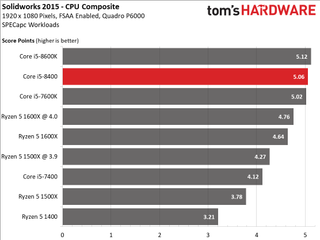
This is also seen in a direct comparison between the Core i5-7600K and Core i5-8400. The latter does not benefit much from its extra cores and larger aggregate cache.

Frequency is all that counts in Creo 3.0. Compared to Intel's Core i5-7600K, the company's -8400 only derives small advantages from its two additional cores.
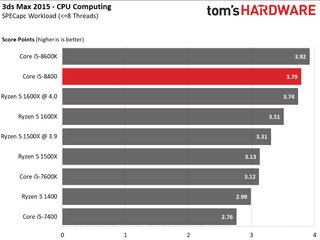
Clock rate and core count both matter in 3ds Max 2015, so the Core i5-8400 lands slightly behind Intel's Core i5-8600K.
Though an overclocked Ryzen 5 1600X is close on Coffee Lake's heels, the -8400 costs less and facilitates higher performance.
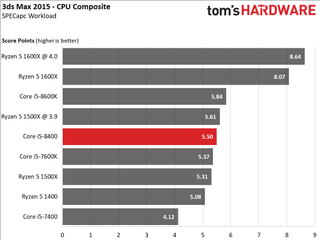
The CPU Composite benchmark makes extensive use of rendering, though, so AMD's Ryzen 5 appears much stronger. Now it's an overclocked 1500X going up against (and beating) Core i5-8400. A lack of Hyper-Threading support likely hurts Intel here.
CPU Performance: Photorealistic rendering
Final rendering doesn’t require a CPU that's good at everything. Rather, this task wants efficiency and fast parallel computation.
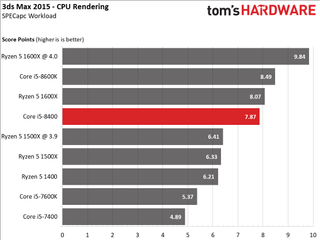
When it comes to pure rendering, the Core i5-8400 offers best-in-class performance. It is only challenged by AMD's pricier Ryzen 5 1600X.

The console variant of LuxRender confirms that none of Intel's Core i5s can compete with the Ryzen 5 1600X, stock or overclocked.

Last, but not least, we take a look at Blender in several different workloads.
The first one, with a sample size of 200 pixels, confirms what we saw in the preceding benchmarks: Core i5-8400 trails the Ryzen 5 1600X by a big margin. In fact, a stock 1600X has little trouble beating the Core i5-8600K by more than 20%.

The results obtained from SPECwpc’s Blender loop look similar, even though this benchmark presents a somewhat different task consisting of more than just rendering. Ryzen 5 takes a big lead over Core i5.

The Core i5-8600K pushes upwards as the amount of pure rendering decreases. The rest of the results look similar, though, and Core i5-8400 suffers from its lack of Hyper-Threading.
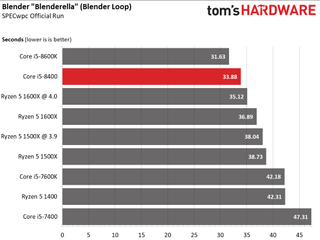
This trend intensifies as our benchmark incorporates tasks other than photorealistic rendering. Core count isn't the sole determiner of performance; IPC throughput factors in as well. The Core i5-8600K even leads, followed by Intel's Core i5-8400.
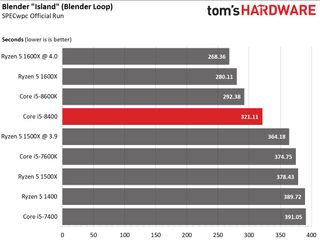
Ryzen 5 1600X jumps to the front once again. Core count matters, of course, but operating frequency is also a critical variable.
Intel’s Core i5-8400 offers acceptable performance in semi-professional applications, so it's more than just a gaming CPU. However, the Core i5 series lacks Hyper-Threading support, which is apparent in highly parallelized workloads. Those tasks tend to favor AMD's Ryzen chips.
Then again, this throws the potent six-core chips right where Intel wants them. If they fared too well, Core i5 would cannibalize sales of the pricier Core i7s.
MORE: Best CPUs
MORE: Intel & AMD Processor Hierarchy
MORE: All CPUs Content
Current page: CPU Computing & Rendering Performance
Prev Page 2D & 3D Workstation Performance Next Page Cooling & TemperatureStay on the Cutting Edge
Join the experts who read Tom's Hardware for the inside track on enthusiast PC tech news — and have for over 25 years. We'll send breaking news and in-depth reviews of CPUs, GPUs, AI, maker hardware and more straight to your inbox.
-
velocityg4 I'd be interested in knowing. Under what circumstances can you get it to hit 3.8Ghz reliably under a 6-core load? That is quite a spread.Reply
If one was to delid the CPU and use a decent CPU cooler. Would it reliably maintain the max turbo boost when the CPU usage demands it? Is the stock heatsink and decent case cooling plenty?
On another note. It is time for the return of the Turbo button. That would be pretty sweet to click the button and manually have the CPU jump between 1, 2, 4 and 6 cores at their respective boost frequencies or down to standard. I know it isn't necessary as it is all automated and that wasn't the purpose of the Turbo button. Some people just like manual control. Plus old time computer geeks would get a kick out of it. -
AgentLozen This is a very neat chip at it's price point. Very little has changed between Kaby Lake and Coffee Lake except for the core count. Luckily for Intel, those added cores make all the difference.Reply
This CPU would sit nicely on a budget system. It's a shame that there are no inexpensive motherboards that it could fit into like the conclusion of this article states.
If you didn't plan to overclock, this is the best CPU on the market for gaming and general productivity. -
The_King We have AMD to thank for all these budget cpu's from Intel, and you all know why! So thank you AMD.Reply -
rwinches No, you can't have charts based on FPS or seconds or related to MSRP. Drivers update, Prices change, Memory Speeds Increase and price lowers, MB prices are wide range.Reply
It is known that Some games work better for AMD when AMD GPUs are used. Game FPS can be dramatically improved by changing just one parameter. Test results that are milliseconds or a few seconds or frames faster are irrelevant and subject to variations in real world use on systems that are not clean installs and have other SW installed and running. -
10tacle Reply20307991 said:No, you can't have charts based on FPS or seconds or related to MSRP. Drivers update, Prices change, Memory Speeds Increase and price lowers, MB prices are wide range.
I don't understand your point. This is a review of the 8400 and comparing it to other CPUs only. Memory, motherboards, and all the other variables are you talking about in a full PC build are irrelevant to this chart comparison. They have to establish a constant standard across the spectrum, and they did so.
20307991 said:It is known that Some games work better for AMD when AMD GPUs are used. Game FPS can be dramatically improved by changing just one parameter. Test results that are milliseconds or a few seconds or frames faster are irrelevant and subject to variations in real world use on systems that are not clean installs and have other SW installed and running.
Again, they are using a single standard across the spectrum comparison. Of course there are infinite combinations of hardware that can game change a little. The bottom line here is that among every major tech review website, all of Intel's chips are better for gaming than Ryzen. The only exception is when dealing with beyond 1080p gaming like QHD or UHD where it's mostly on the GPU. People who buy this chip are the perfect candidate for a 144Hz 1080p G-sync or Freesync monitor.
-
elbert Compared to the Ryzen 1600 with a B350 its $50 higher. That is a higher video card level. IE get the 8400 with a 1050ti the Ryzen budget would get a 1060 3GB. Intel needs their B360 motherboards for the 8100 and 8400 to ever be a budget winner.Reply -
hardwarefox1234 Has the author even bothered to look at the street prices for the CPUs??Reply
Core i5 8400:
https://www.newegg.com/Product/Product.aspx?Item=9SIA7HN6HF3442&cm_re=i5_8400-_-9SIA7HN6HF3442-_-Product
http://www.microcenter.com/product/486090/core_i5-8400_coffee_lake_28_ghz_lga_1151_boxed_processor
http://www.ncixus.com/products/?sku=142465&vpn=BX80684I58400&manufacture=Intel
The lowest price is $249.99!
The Ryzen 5 1600 is much cheaper:
https://www.newegg.com/Product/Product.aspx?Item=N82E16819113435&cm_re=ryzen_5_1600-_-19-113-435-_-Product
http://www.microcenter.com/product/478826/Ryzen_5_1600_32GHz_6_Core_AM4_Boxed_Processor_with_Wraith_Spire_Cooler
http://www.ncixus.com/products/?sku=139481&vpn=YD1600BBAEBOX&manufacture=AMD
https://www.amazon.com/AMD-Processor-Wraith-Cooler-YD1600BBAEBOX/dp/B06XNRQHG4/ref=sr_1_3?s=pc&ie=UTF8&qid=1508952175&sr=1-3&keywords=ryzen+5+1600
Price is $199.99~$219.99!
Then if you add the price of the B350 motherboards,they start at a lower level than the Z370 ones. -
hixbot Why did you label section 10, overclocking, cooling and temperature? There's no overlocking on this chip? I would have like to see at least an attempt at Bclk overlcock with a mobo that has a clock generator.Reply -
TJ Hooker I really wish more reviewers would look at what sort of boost clocks the i5 8400 can sustain under load, with the stock cooler as well as aftermarket. From what I know you could typically assume past Intel CPUs would operate at or near max turbo almost indefinitely, but with a 50% increase in core count and such an unusually wide gap between base and boost clocks (not unlike their mobile CPUs), I'm curious how Coffee Lake will behave in that regard.Reply
